一、理论知识
多线程是进程执行过程中产生的多条执行线索。线程是比进程执行更小的单位。线程不能独立存在,必须存在于进程中,同一进程的各线程间共享进程空间的数据。每个线程有它自身的产生、存在和消亡的过程,是一个动态的概念。多线程意味着一个程序的多行语句可以看上去几乎在同一时间内同时运行。线程创建、销毁和切换的负荷远小于进程,又称为轻量级进程。
线程两种创建方法比较:实现Runnable接口的优势:符合OO设计的思想;便于用extends继承其它类。采用继承Thread类方法的优点:代码简单。
线程的终止:当线程的run方法执行方法体中最后一条语句后,或者出现了在run方法中没有捕获的异常时,线程将终止,让出CPU使用权。调用interrupt()方法也可终止线程。 void interrupt() :向一个线程发送一个中断请求,同时把这个线程的“interrupted”状态置为true。若该线程处于 blocked 状 态,会抛出 InterruptedException。
测试线程是否被中断的方法:static boolean interrupted() :检测当前线程是否已被中断,并重置状态 “interrupted”值为false。 boolean isInterrupted() :检测当前线程是否已被中断 , 不改变状态 “interrupted”值 。
利用各线程的状态变换,可以控制各个线程轮流 使用CPU,体现多线程的并行性特征。
Java实现多线程有两种途径:创建Thread类的子类;在程序中定义实现Runnable接口的类。
用Thread类的子类创建线程:首先需从Thread类派生出一个子类,在该子类中重写run()方法。然后用创建该子类的对象Lefthand left=new Lefthand(); Righthand right=new Righthand();最后用start()方法启动线程 left.start(); right.start();
用Thread类的子类创建多线程的关键性操作:定义Thread类的子类并实现用户线程操作,即run()方法的实现。在适当的时候启动线程。由于Java只支持单重继承,用这种方法定义的类不可再继承其他父类。
用Runnable()接口实现线程:首先设计一个实现Runnable接口的类;然后在类中根据需要重写run方法;再创建该类对象,以此对象为参数建立Thread 类的对象;调用Thread类对象的start方法启动线程,将 CPU执行权转交到run方法。
Thread(Runnable r):创建一个新线程,它调用r的run(), r是一个实现了Runnable接口的类的实例。
测试线程是否被中断的方法:static boolean interrupted() :检测当前线程是否已被中断,并重置状态 “interrupted”值为false。 boolean isInterrupted() :检测当前线程是否已被中断 , 不改变状态 “interrupted”值 。
利用各线程的状态变换,可以控制各个线程轮流 使用CPU,体现多线程的并行性特征。
线程有如下7种状态:New (新建);Runnable (可运行);Running(运行) ;Blocked (被阻塞) ;Waiting (等待) ;Timed waiting (计时等待) ; Terminated (被终止)。
new(新建):线程对象刚刚创建,还没有启动,此时线程还处于不可运行状态。例如: Thread thread=new Thread(r); 此时线程thread处于新建状态,有了相应的内存空间以及其它资源。
runnable(可运行状态):此时线程已经启动,处于线程的run()方法之中。此时的线程可能运行,也可能不运行,只要 CPU一空闲,马上就会运行。调用线程的start()方法可使线程处于“可运行”状态。例如: thread.start();
blocked (被阻塞):一个正在执行的线程因特殊原因,被暂停执行,进入阻塞状态。阻塞时线程不能进入队列排队,必须等到引起阻塞的原因消除,才可重新进入排队队列。引起阻塞的原因很多,不同原因要用不同的方法解除。sleep(),wait()是两个常用引起线程阻塞的方法。
线程阻塞的三种情况:等待阻塞:通过调用线程的wait()方法,让线程等待某工作的完成。同步阻塞:线程在获取synchronized同步锁失败(因为锁被其它线程所占用),它会进入同步阻 塞状态。 其他阻塞:通过调用线程的sleep()或join() 或发出了I/O请求时,线程会进入到阻塞状态。当 sleep()状态超时、join()等待线程终止或者超时、或者I/O处理完毕时,线程重新转入就绪状态。
Terminated (被终止) :线程被终止的原因有二:一是run()方法中最后一个语句执行完毕而自 然死亡。二是因为一个没有捕获的异常终止了run方法而意外死亡。可以调用线程的 stop 方法杀死一个线程(thread.stop();),但是,stop方法已过时,不要在自己的代码中调用它。
线程的挂起和恢复: suspend() 和 resume() 方法:两个方法可配套使用,suspend()使得线程进入阻塞状态,并且不会自动恢复,必须其对应的 resume()被调用, 才能使得线程重新进入可执行状态。但这种方法很容易引起线程死锁问题,已不推荐使用。
其他判断和影响线程状态的方法:join():等待指定线程的终止。 join(long millis):经过指定时间等待终止指定的线程。 isAlive():测试当前线程是否在活动。 yield():让当前线程由“运行状态”进入到“就绪状态” ,从而让其它具有相同优先级的等待线程获取执行权。
Thread类有三个与线程优先级有关的静态量: MAX_PRIORITY:最大优先权,值为10; MIN_PRIORITY:最小优先权,值为1; NORM _PRIORITY:默认优先权,值为5。
调用setPriority(int a)重置当前线程的优先级,a取值可以是前述的三个静态量。调用getPriority()获得当前线程优先级。
下面几种情况下,当前运行线程会放弃CPU:线程调用了yield() 或sleep() 方法;抢先式系统下,有高优先级的线程参与调度;由于当前线程进行I/O访问、外存读写、等待用 户输入等操作导致线程阻塞;或者是为等候一个条件变量,以及线程调用wait() 方法。
守护线程的惟一用途是为其他线程提供服务。例如计时线程。在一个线程启动之前,调用setDaemon方法可将线程转换为守护线程。例如:setDaemon(true)
在Java中解决多线程同步问题的方法有两种:J ava SE 5.0中引入ReentrantLock类。 在共享内存的类方法前加synchronized修饰符。
有关锁对象和条件对象的关键要点:锁用来保护代码片段,保证任何时刻只能有一个线程执行被保护的代码。锁管理试图进入被保护代码段的线程。锁可拥有一个或多个相关条件对象。每个条件对象管理那些已经进入被保护的代码 段但还不能运行的线程。
二、实验部分
1、实验目的与要求
(1) 掌握线程概念;
(2) 掌握线程创建的两种技术;
(3) 理解和掌握线程的优先级属性及调度方法;
(4) 掌握线程同步的概念及实现技术;
2、实验内容和步骤
实验1:测试程序并进行代码注释。
测试程序1:
l 在elipse IDE中调试运行ThreadTest,结合程序运行结果理解程序;
l 掌握线程概念;
l 掌握用Thread的扩展类实现线程的方法;
l 利用Runnable接口改造程序,掌握用Runnable接口创建线程的方法。
class Lefthand extends Thread { public void run() { for(int i=0;i<=5;i++) { System.out.println("You are Students!"); try{ sleep(500); } catch(InterruptedException e) { System.out.println("Lefthand error.");} } } } class Righthand extends Thread { public void run() { for(int i=0;i<=5;i++) { System.out.println("I am a Teacher!"); try{ sleep(300); } catch(InterruptedException e) { System.out.println("Righthand error.");} } } } public class ThreadTest { static Lefthand left; static Righthand right; public static void main(String[] args) { left=new Lefthand(); right=new Righthand(); left.start(); right.start(); } }
用Runnable接口改造程序的程序:
lass Lefthand implements Runnable { public void run() { for (int i = 0; i <= 5; i++) { System.out.println("You are Students!"); try { Thread.sleep(500); } catch (InterruptedException e) { System.out.println("Lefthand error."); } } } } class Righthand implements Runnable { public void run() { for (int i = 0; i <= 5; i++) { System.out.println("I am a Teacher!"); try { Thread.sleep(300); } catch (InterruptedException e) { System.out.println("Righthand error."); } } } } public class ThreadTest { static Thread left; static Thread right; public static void main(String[] args) { Runnable a = new Lefthand(); Runnable b = new Righthand(); left = new Thread(a); right = new Thread(b); left.startq(); right.start(); } }
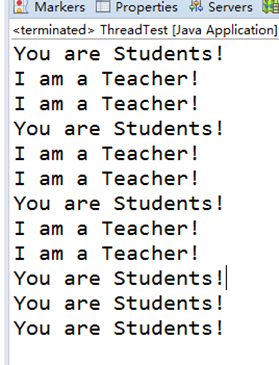
测试程序2:
l 在Elipse环境下调试教材625页程序14-1、14-2 、14-3,结合程序运行结果理解程序;
package bounce; import java.awt.*; import java.awt.event.*; import javax.swing.*; /** * Shows an animated bouncing ball. * * @version 1.34 2015-06-21 * @author Cay Horstmann */ public class Bounce { public static void main(String[] args) { EventQueue.invokeLater(() -> { JFrame frame = new BounceFrame(); frame.setDefaultCloseOperation(JFrame.EXIT_ON_CLOSE); frame.setVisible(true); }); } } /** * The frame with ball component and buttons. */ class BounceFrame extends JFrame { private BallComponent comp; public static final int STEPS = 1000; public static final int DELAY = 3; /** * Constructs the frame with the component for showing the bouncing ball and * Start and Close buttons */ public BounceFrame() { setTitle("Bounce");// 设置窗体的标题 comp = new BallComponent(); add(comp, BorderLayout.CENTER);// 中间区域的布局约束 JPanel buttonPanel = new JPanel(); addButton(buttonPanel, "Start", event -> addBall());// 添加Start按钮 addButton(buttonPanel, "Close", event -> System.exit(0));// 添加Close按钮 add(buttonPanel, BorderLayout.SOUTH);// 南区域的布局约束 pack();// 调整窗口大小 } /** * Adds a button to a container. * * @param c * the container * @param title * the button title * @param listener * the action listener for the button */ public void addButton(Container c, String title, ActionListener listener) { JButton button = new JButton(title); c.add(button); button.addActionListener(listener); } /** * Adds a bouncing ball to the panel and makes it bounce 1,000 times. */ public void addBall() { try { Ball ball = new Ball(); comp.add(ball); for (int i = 1; i <= STEPS; i++) { ball.move(comp.getBounds()); comp.paint(comp.getGraphics()); Thread.sleep(DELAY);// 在指定的毫秒数内让当前正在执行的线程休眠 } } catch (InterruptedException e) { } } }
package bounce; import java.awt.geom.*; /** * A ball that moves and bounces off the edges of a rectangle * * @version 1.33 2007-05-17 * @author Cay Horstmann */ public class Ball { private static final int XSIZE = 15; private static final int YSIZE = 15; private double x = 0; private double y = 0; private double dx = 1; private double dy = 1; /** * Moves the ball to the next position, reversing direction if it hits one of * the edges */ public void move(Rectangle2D bounds) { x += dx; y += dy; if (x < bounds.getMinX()) { x = bounds.getMinX();// 以 double 精度返回 Shape 窗体矩形的最小 X 坐标 dx = -dx; } if (x + XSIZE >= bounds.getMaxX()) { x = bounds.getMaxX() - XSIZE; dx = -dx; } if (y < bounds.getMinY()) { y = bounds.getMinY();// 以 double 精度返回 Shape 窗体矩形的最小 Y 坐标 dy = -dy; } if (y + YSIZE >= bounds.getMaxY()) { y = bounds.getMaxY() - YSIZE; dy = -dy; } } /** * Gets the shape of the ball at its current position. */ public Ellipse2D getShape() { return new Ellipse2D.Double(x, y, XSIZE, YSIZE);// 根据指定坐标构造和初始化 Ellipse2D }
package bounce; import java.awt.*; import java.util.*; import javax.swing.*; /** * The component that draws the balls. * * @version 1.34 2012-01-26 * @author Cay Horstmann */ public class BallComponent extends JPanel { private static final int DEFAULT_WIDTH = 450; private static final int DEFAULT_HEIGHT = 350; private java.util.List<Ball> balls = new ArrayList<>(); /** * Add a ball to the component. * * @param b * the ball to add */ public void add(Ball b) { balls.add(b); } public void paintComponent(Graphics g) { super.paintComponent(g); // erase background Graphics2D g2 = (Graphics2D) g; for (Ball b : balls) { g2.fill(b.getShape()); } } public Dimension getPreferredSize() { return new Dimension(DEFAULT_WIDTH, DEFAULT_HEIGHT); } }
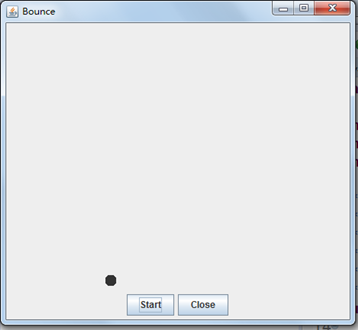
l 在Elipse环境下调试教材631页程序14-4,结合程序运行结果理解程序;
package bounceThread; import java.awt.*; import java.awt.event.*; import javax.swing.*; /** * Shows animated bouncing balls. * * @version 1.34 2015-06-21 * @author Cay Horstmann */ public class BounceThread { public static void main(String[] args) { EventQueue.invokeLater(() -> { JFrame frame = new BounceFrame(); frame.setTitle("BounceThread");//设置标题 frame.setDefaultCloseOperation(JFrame.EXIT_ON_CLOSE); frame.setVisible(true); }); } } /** * The frame with panel and buttons. */ class BounceFrame extends JFrame { private BallComponent comp; public static final int STEPS = 1000; public static final int DELAY = 5; /** * Constructs the frame with the component for showing the bouncing ball and * Start and Close buttons */ public BounceFrame() { comp = new BallComponent(); add(comp, BorderLayout.CENTER);//中间区域的布局约束 JPanel buttonPanel = new JPanel();//创建具有双缓冲和流布局的新 JPanel。 addButton(buttonPanel, "Start", event -> addBall());//添加Start按钮 addButton(buttonPanel, "Close", event -> System.exit(0));//添加Close按钮 add(buttonPanel, BorderLayout.SOUTH);//南区域的布局约束(容器底部) pack();//调整窗口的大小 } /** * Adds a button to a container. * * @param c the container * @param title the button title * @param listener the action listener for the button */ public void addButton(Container c, String title, ActionListener listener) { JButton button = new JButton(title); c.add(button); button.addActionListener(listener); } /** * Adds a bouncing ball to the canvas and starts a thread to make it bounce */ public void addBall() { Ball ball = new Ball(); comp.add(ball); Runnable r = () -> { try { for (int i = 1; i <= STEPS; i++) { ball.move(comp.getBounds()); comp.repaint();//重绘组件 Thread.sleep(DELAY);//在指定的毫秒数内让当前正在执行的线程休眠 } } catch (InterruptedException e) { } }; Thread t = new Thread(r); t.start(); } }
package bounceThread; import java.awt.geom.*; /** A ball that moves and bounces off the edges of a rectangle * @version 1.33 2007-05-17 * @author Cay Horstmann */ public class Ball { private static final int XSIZE = 15; private static final int YSIZE = 15; private double x = 0; private double y = 0; private double dx = 1; private double dy = 1; /** Moves the ball to the next position, reversing direction if it hits one of the edges */ public void move(Rectangle2D bounds) { x += dx; y += dy; if (x < bounds.getMinX()) { x = bounds.getMinX();//以 double 精度返回 Shape 窗体矩形的最小 X 坐标 dx = -dx; } if (x + XSIZE >= bounds.getMaxX()) { x = bounds.getMaxX() - XSIZE; dx = -dx; } if (y < bounds.getMinY()) { y = bounds.getMinY(); //根据指定坐标构造和初始化 Ellipse2D dy = -dy; } if (y + YSIZE >= bounds.getMaxY()) { y = bounds.getMaxY() - YSIZE; dy = -dy; } } /** Gets the shape of the ball at its current position. */ public Ellipse2D getShape() { return new Ellipse2D.Double(x, y, XSIZE, YSIZE);//根据指定坐标构造和初始化 Ellipse2D } }
package bounceThread; import java.awt.*; import java.util.*; import javax.swing.*; /** * The component that draws the balls. * * @version 1.34 2012-01-26 * @author Cay Horstmann */ public class BallComponent extends JComponent { private static final int DEFAULT_WIDTH = 450; private static final int DEFAULT_HEIGHT = 350; private java.util.List<Ball> balls = new ArrayList<>(); /** * Add a ball to the panel. * * @param b the ball to add */ public void add(Ball b) { balls.add(b); } public void paintComponent(Graphics g) { Graphics2D g2 = (Graphics2D) g; for (Ball b : balls) { g2.fill(b.getShape()); } } public Dimension getPreferredSize() { return new Dimension(DEFAULT_WIDTH, DEFAULT_HEIGHT);//构造一个 Dimension,并将其初始化为指定宽度和高度。 } }
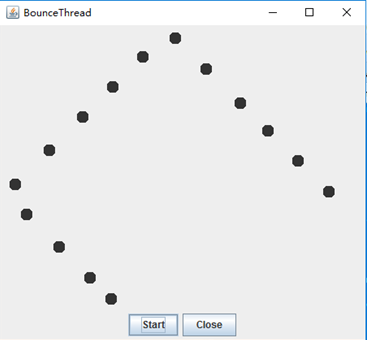
l 对比两个程序,理解线程的概念和用途;
l 掌握线程创建的两种技术。
测试程序3:分析以下程序运行结果并理解程序。
class Race extends Thread { public static void main(String args[]) { Race[] runner = new Race[4]; for (int i = 0; i < 4; i++) runner[i] = new Race(); for (int i = 0; i < 4; i++) runner[i].start(); runner[1].setPriority(MIN_PRIORITY); runner[3].setPriority(MAX_PRIORITY); } public void run() { for (int i = 0; i < 1000000; i++);// 执行空语句,用来延时,也可以换成sleep,sleep会释放CPU,会抛出异常 System.out.println(getName() + "线程的优先级是" + getPriority() + "已计算完毕!"); } }

测试程序4
l 教材642页程序模拟一个有若干账户的银行,随机地生成在这些账户之间转移钱款的交易。每一个账户有一个线程。在每一笔交易中,会从线程所服务的账户中随机转移一定数目的钱款到另一个随机账户。
l 在Elipse环境下调试教材642页程序14-5、14-6,结合程序运行结果理解程序;
package unsynch; import java.util.*; /** * 有许多银行账户的银行。 * @version 1.30 2004-08-01 * @author Cay Horstmann */ public class Bank { private final double[] accounts; /** *构建了银行。 * @param n账户数量 * @param 每个帐户的初始余额 */ public Bank(int n, double initialBalance) { accounts = new double[n]; Arrays.fill(accounts, initialBalance); } /** * 把钱从一个账户转到另一个账户。 * @param 从账户转出 * @param 到账转到 * @param 转帐金额 */ public void transfer(int from, int to, double amount) { if (accounts[from] < amount) return; System.out.print(Thread.currentThread()); accounts[from] -= amount; System.out.printf(" %10.2f from %d to %d", amount, from, to); accounts[to] += amount; System.out.printf(" Total Balance: %10.2f%n", getTotalBalance()); } /** * 获取所有帐户余额的总和。 * @return 总平衡 */ public double getTotalBalance() { double sum = 0; for (double a : accounts) sum += a; return sum; } /** * 获取银行中的帐户编号。 * @return 账户数量 */ public int size() { return accounts.length; } }
package unsynch; /** * 当多个线程访问一个数据结构时,这个程序显示数据损坏。 * @version 1.31 2015-06-21 * @author Cay Horstmann */ public class UnsynchBankTest { public static final int NACCOUNTS = 100; public static final double INITIAL_BALANCE = 1000; public static final double MAX_AMOUNT = 1000; public static final int DELAY = 10; public static void main(String[] args) { Bank bank = new Bank(NACCOUNTS, INITIAL_BALANCE); for (int i = 0; i < NACCOUNTS; i++) { int fromAccount = i; Runnable r = () -> { try { while (true) { int toAccount = (int) (bank.size() * Math.random()); double amount = MAX_AMOUNT * Math.random(); bank.transfer(fromAccount, toAccount, amount); Thread.sleep((int) (DELAY * Math.random())); } } catch (InterruptedException e) { } }; Thread t = new Thread(r); t.start(); } } }

综合编程练习
编程练习1
1. 设计一个用户信息采集程序,要求如下:
(1) 用户信息输入界面如下图所示:
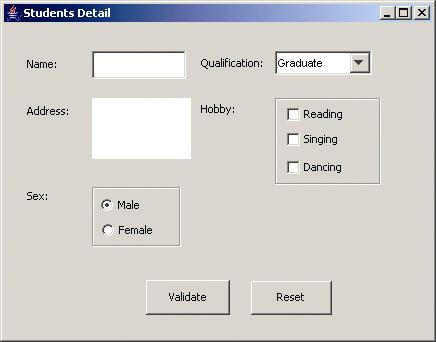
(2) 用户点击提交按钮时,用户输入信息显示控制台界面;
(3) 用户点击重置按钮后,清空用户已输入信息;
(4) 点击窗口关闭,程序退出。
package t; import java.awt.EventQueue; import javax.swing.JFrame; public class Mian { public static void main(String[] args) { EventQueue.invokeLater(() -> { DemoJFrame page = new DemoJFrame(); }); } }
package t; import java.awt.Dimension; import java.awt.Toolkit; import java.awt.Window; public class WinCenter { public static void center(Window win){ Toolkit tkit = Toolkit.getDefaultToolkit();//获取默认工具包 Dimension sSize = tkit.getScreenSize();//获取屏幕的大小 Dimension wSize = win.getSize(); if(wSize.height > sSize.height){ wSize.height = sSize.height; } if(wSize.width > sSize.width){ wSize.width = sSize.width; } win.setLocation((sSize.width - wSize.width)/ 2, (sSize.height - wSize.height)/ 2);//将组件移到新的位置 } }
package t; import java.awt.*; import java.awt.event.*; import javax.swing.*; import javax.swing.border.*; public class Demo extends JFrame { public Demo() { JPanel panel1 = new JPanel(); panel1.setPreferredSize(new Dimension(700, 45)); panel1.setLayout(new GridLayout(1, 4)); JLabel label1 = new JLabel("Name:"); JTextField j1 = new JTextField(""); JLabel label2 = new JLabel("Qualification:"); JComboBox<Object> j2 = new JComboBox<>(); j2.addItem("Graduate"); j2.addItem("Not Graduate"); panel1.add(label1); panel1.add(j1); panel1.add(label2); panel1.add(j2); JPanel panel2 = new JPanel(); panel2.setPreferredSize(new Dimension(700, 50)); panel2.setLayout(new GridLayout(1, 4)); JLabel label3 = new JLabel("Address:"); JTextArea j3 = new JTextArea(); JLabel label4 = new JLabel("Hobby:"); JPanel p = new JPanel(); p.setLayout(new GridLayout(3, 1)); p.setBorder(BorderFactory.createLineBorder(null)); JCheckBox c1 = new JCheckBox("Reading"); JCheckBox c2 = new JCheckBox("Singing"); JCheckBox c3 = new JCheckBox("Dancing"); p.add(c1); p.add(c2); p.add(c3); panel2.add(label3); panel2.add(j3); panel2.add(label4); panel2.add(p); JPanel panel3 = new JPanel(); panel3.setPreferredSize(new Dimension(700, 150)); FlowLayout flowLayout1 = new FlowLayout(FlowLayout.CENTER, 50, 10); panel3.setLayout(flowLayout1); JLabel label5 = new JLabel("Sex:"); JPanel p1 = new JPanel(); p1.setLayout(new GridLayout(2, 1)); p1.setBorder(BorderFactory.createLineBorder(null)); ButtonGroup bu = new ButtonGroup(); JRadioButton jr1 = new JRadioButton("Male"); JRadioButton jr2 = new JRadioButton("Female"); bu.add(jr1); bu.add(jr2); p1.add(jr1); p1.add(jr2); panel3.add(label5); panel3.add(p1); add(panel1); add(panel2); add(panel3); JPanel panel4 = new JPanel(); panel4.setPreferredSize(new Dimension(700, 150)); JButton b1 = new JButton("Validate"); panel4.add(b1); JButton b2 = new JButton("Reset"); panel4.add(b2); add(panel4); FlowLayout flowLayout = new FlowLayout(); this.setLayout(flowLayout); this.setTitle("Students Detail"); this.setBounds(200, 200, 800, 400); this.setVisible(true); this.setDefaultCloseOperation(DISPOSE_ON_CLOSE); b1.addActionListener(new ActionListener() { @Override public void actionPerformed(ActionEvent e) { // TODO 自动生成的方法存根 String xueli = j2.getSelectedItem().toString(); System.out.println("Name:" + j1.getText()); System.out.println("Qualification:" + xueli); String hobbystring = "Hobby:"; if (c1.isSelected()) { hobbystring += "Reading"; } if (c2.isSelected()) { hobbystring += "Singing"; } if (c3.isSelected()) { hobbystring += "Dancing"; } System.out.println("Address:" + j3.getText()); if (jr1.isSelected()) { System.out.println("Sex:Male"); } if (jr2.isSelected()) { System.out.println("Sex:Female"); } System.out.println(hobbystring); } }); b2.addActionListener(new ActionListener() { @Override public void actionPerformed(ActionEvent e) { // TODO 自动生成的方法存根 j1.setText(null); j3.setText(null); j2.setSelectedIndex(0); c1.setSelected(false); c2.setSelected(false); c3.setSelected(false); bu.clearSelection(); } }); }
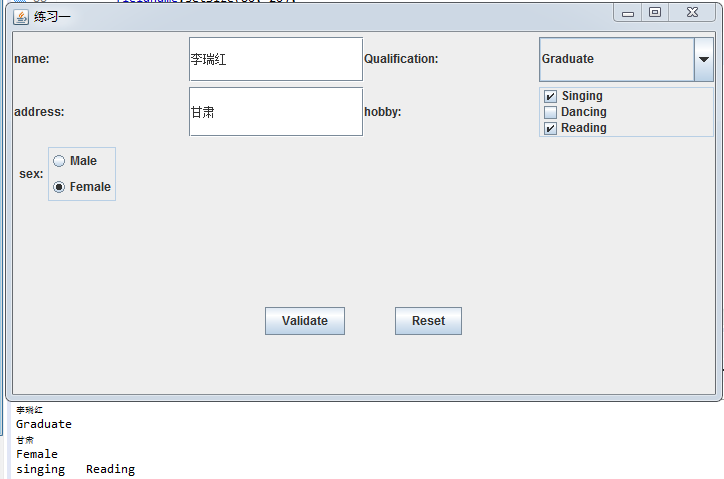
2.创建两个线程,每个线程按顺序输出5次“你好”,每个“你好”要标明来自哪个线程及其顺序号。
class Lefthand implements Runnable { public void run() { for (int i = 0; i < 5; i++) { System.out.println(i + 1 + ":a.你好!"); try { Thread.sleep(500); } catch (InterruptedException e) { System.out.println("Lefthand error."); } } } } class Righthand implements Runnable { public void run() { for (int i = 0; i < 5; i++) { System.out.println(i + 1 + ":b.你好!"); try { Thread.sleep(300); } catch (InterruptedException e) { System.out.println("Righthand error."); } } } } public class ThreadTest { public static void main(String[] args) { Runnable left = new Lefthand(); Thread l = new Thread(left); Runnable right = new Righthand(); Thread r = new Thread(right); l.start(); r.start(); } }
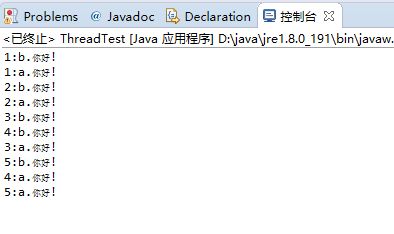
3. 完善实验十五 GUI综合编程练习程序。
身份证:
import java.awt.*; import java.awt.event.*; import java.io.*; import java.util.*; import javax.swing.*; public class Main extends JFrame { private static ArrayList<Card> cardlist; private static ArrayList<Card> list; private JPanel panel; private JPanel Panel1; private static final int DEFAULT_WITH = 600; private static final int DEFAULT_HEIGHT = 300; public Main() { cardlist = new ArrayList<>(); Scanner scanner = new Scanner(System.in); File file = new File("E:\\身份证号.txt"); try { FileInputStream fis = new FileInputStream(file); BufferedReader in = new BufferedReader(new InputStreamReader(fis)); String temp = null; while ((temp = in.readLine()) != null) { Scanner linescanner = new Scanner(temp); linescanner.useDelimiter(" "); String name = linescanner.next(); String id = linescanner.next(); String sex = linescanner.next(); String age = linescanner.next(); String area = linescanner.nextLine(); Card card = new Card(); card.setName(name); card.setId(id); card.setSex(sex); int a = Integer.parseInt(age); card.setAge(a); card.setArea(area); cardlist.add(card); } } catch (FileNotFoundException e) { // TODO Auto-generated catch block System.out.println("信息文件找不到"); e.printStackTrace(); } catch (IOException e) { // TODO Auto-generated catch block System.out.println("信息文件读取错误"); e.printStackTrace(); } panel = new JPanel(); panel.setLayout(new BorderLayout()); JTextArea jt = new JTextArea(); panel.add(jt); add(panel, BorderLayout.NORTH); Panel1 = new JPanel(); Panel1.setLayout(new GridLayout(1, 9)); JButton jButton = new JButton("字典排序"); JButton jButton1 = new JButton("年龄最大和年龄最小"); JLabel lab = new JLabel("寻找老乡:", Label.LEFT); JTextField jt1 = new JTextField(); JLabel lab1 = new JLabel("寻找年龄相近的人:", Label.LEFT); JTextField jt2 = new JTextField(); JLabel lab2 = new JLabel("输入你的身份证号码:", Label.LEFT); JTextField jt3 = new JTextField(); JButton jButton2 = new JButton("退出"); jButton.addActionListener(new ActionListener() { @Override public void actionPerformed(ActionEvent e) { // TODO 自动生成的方法存根 Collections.sort(cardlist); jt.setText(cardlist.toString()); } }); jButton1.addActionListener(new ActionListener() { @Override public void actionPerformed(ActionEvent e) { // TODO 自动生成的方法存根 int max = 0, min = 100; int j, k1 = 0, k2 = 0; for (int i = 1; i < cardlist.size(); i++) { j = cardlist.get(i).getAge(); if (j > max) { max = j; k1 = i; } if (j < min) { min = j; k2 = i; } } jt.setText("年龄最大:" + cardlist.get(k1) + "年龄最小:" + cardlist.get(k2)); } }); jButton2.addActionListener(new ActionListener() { public void actionPerformed(ActionEvent e) { dispose(); System.exit(0); } }); jt1.addActionListener(new ActionListener() { public void actionPerformed(ActionEvent e) { String find = jt1.getText(); String text = ""; String place = find.substring(0, 3); for (int i = 0; i < cardlist.size(); i++) { if (cardlist.get(i).getArea().substring(1, 4).equals(place)) { text += "\n" + cardlist.get(i); jt.setText("老乡:" + text); } } } }); jt2.addActionListener(new ActionListener() { public void actionPerformed(ActionEvent e) { String yourage = jt2.getText(); int a = Integer.parseInt(yourage); int near = agenear(a); jt.setText("年龄相近:" + cardlist.get(near)); } }); jt3.addKeyListener(new KeyAdapter() { public void keyTyped(KeyEvent e) { // TODO 自动生成的方法存根 list = new ArrayList<>(); Collections.sort(cardlist); String key = jt3.getText(); for (int i = 1; i < cardlist.size(); i++) { if (cardlist.get(i).getId().contains(key)) { list.add(cardlist.get(i)); jt.setText("你可能是:\n" + list); } } } }); Panel1.add(jButton); Panel1.add(jButton1); Panel1.add(lab); Panel1.add(jt1); Panel1.add(lab1); Panel1.add(jt2); Panel1.add(lab2); Panel1.add(jt3); Panel1.add(jButton2); add(Panel1, BorderLayout.SOUTH); setSize(DEFAULT_WITH, DEFAULT_HEIGHT); } public static int agenear(int age) { int j = 0, min = 100, value = 0, k = 0; for (int i = 0; i < cardlist.size(); i++) { value = cardlist.get(i).getAge() - age; if (value < 0) value = -value; if (value < min) { min = value; k = i; } } return k; } }
public class Card implements Comparable<Card> { private String name; private String id; private String sex; private int age; private String area; public String getName() { return name; } public void setName(String name) { this.name = name; } public String getId() { return id; } public void setId(String id) { this.id = id; } public String getSex() { return sex; } public void setSex(String sex) { this.sex = sex; } public int getAge() { return age; } public void setAge(int age) { this.age = age; } public String getArea() { return area; } public void setArea(String area) { this.area = area; } public int compareTo(Card c) { return this.name.compareTo(c.getName()); } public String toString() { return name + "\t" + id + "\t" + sex + "\t" + age + "\t" + area + "\n"; } }
import java.awt.*; import javax.swing.*; public class CardTest { public static void main(String[] args) { EventQueue.invokeLater(() -> { JFrame frame = new Main(); frame.setTitle("身份证"); frame.setDefaultCloseOperation(JFrame.EXIT_ON_CLOSE); frame.setVisible(true); }); } }
四则运算
import java.awt.*; import java.awt.event.*; import java.io.*; import java.util.*; import javax.swing.*; public class Demo extends JFrame { int i = 0, i1 = 0, k = 0, sum = 0; private PrintWriter out = null; private String[] c1 = new String[10]; private String[] c2 = new String[10]; public Demo() { JPanel panel = new JPanel(); panel.setLayout(new GridLayout(1, 3)); JTextArea jt1 = new JTextArea(); JTextField jt2 = new JTextField(); JTextArea jt3 = new JTextArea(); panel.add(jt1); panel.add(jt2); panel.add(jt3); add(panel, BorderLayout.NORTH); JPanel panel1 = new JPanel(); panel1.setLayout(new GridLayout(1, 2)); Button button1 = new Button("生成题目"); Button button2 = new Button("生成文件"); panel1.add(button1); panel1.add(button2); add(panel1, BorderLayout.SOUTH); setSize(600, 300); button1.addActionListener(new ActionListener() { @Override public void actionPerformed(ActionEvent e) { // TODO 自动生成的方法存根 jt2.setText(null); jt3.setText(null); if (i < 10) { int a = (int) (Math.random() * 100); int b = (int) (Math.random() * 100); int m = (int) Math.round(Math.random() * 3); switch (m) { case 0: while (b == 0 || a % b != 0) { b = (int) Math.round(Math.random() * 100); a = (int) Math.round(Math.random() * 100); } jt1.setText(i + 1 + ": " + a + "/" + b + "="); c1[i] = jt1.getText(); k = a / b; i++; break; case 1: jt1.setText(i + 1 + ": " + a + "*" + b + "="); c1[i] = jt1.getText(); k = a * b; i++; break; case 2: jt1.setText(i + 1 + ": " + a + "+" + b + "="); c1[i] = jt1.getText(); k = a + b; i++; break; case 3: while (a < b) { int x = a; a = b; b = x; } jt1.setText(i + 1 + ": " + a + "-" + b + "="); c1[i] = jt1.getText(); k = a - b; i++; break; } } } }); jt2.addActionListener(new ActionListener() { @Override public void actionPerformed(ActionEvent e) { // TODO 自动生成的方法存根 if (i < 11) { int find = Integer.parseInt(jt2.getText()); String d = jt2.getText().toString().trim(); if (jt2.getText() != "") { if (find == k) { sum += 10; jt3.setText("答案正确"); } else jt3.setText("答案错误"); } c2[i1] = d; i1++; } } }); button2.addActionListener(new ActionListener() { @Override public void actionPerformed(ActionEvent e) { // TODO 自动生成的方法存根 try { out = new PrintWriter("text.txt"); } catch (FileNotFoundException e1) { // TODO Auto-generated catch block e1.printStackTrace(); } for (int counter = 0; counter < 10; counter++) { out.println(c1[counter] + c2[counter]); } out.println("成绩为" + sum); out.close(); } }); } }
import java.awt.*; import javax.swing.*; public class DemoTest { public static void main(String[] args) { EventQueue.invokeLater(() -> { JFrame frame = new Demo(); frame.setTitle("计算题"); frame.setDefaultCloseOperation(JFrame.EXIT_ON_CLOSE); frame.setVisible(true); }); } }
实验总结:
多线程是进程执行过程中产生的多条执行线索。线程是比进程执行更小的单位。线程不能独立存在,必须存在于进程中,同一进程的各线程间共享进程空间的数据。每个线程有它自身的产生、存在和消亡的过程,是一个动态的概念。多线程意味着一个程序的多行语句可以看上去几乎在同一时间内同时运行。线程创建、销毁和切换的负荷远小于进程,又称为轻量级进程。
线程两种创建方法比较:实现Runnable接口的优势:符合OO设计的思想;便于用extends继承其它类。采用继承Thread类方法的优点:代码简单。
Java 的线程调度采用优先级策略:优先级高的先执行,优先级低的后执行;多线程系统会自动为每个线程分配一个优先级,缺省时,继承其父类的优先级; 任务紧急的线程,其优先级较高; 同优先级的线程按“先进先出”的队列原则。
感受:对布局的大小设置不是太明白,感觉有些参数变了但是布局的大小并没有发生变化。




